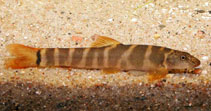http://www.fishbase.org/Summary/speciesSummary.php?genusname=Schistura&speciesname=magnifluvis ---> http://192.134.151.83/Summary/speciesSummary.php?genusname=Schistura&speciesname=magnifluvis
http://192.134.151.83/Summary/speciesSummary.php?genusname=Schistura&speciesname=magnifluvis ---> https://fishbase.mnhn.fr/Summary/speciesSummary.php?genusname=Schistura&speciesname=magnifluvis
https://fishbase.mnhn.fr/Summary/speciesSummary.php?genusname=Schistura&speciesname=magnifluvis ---> https://fishbase.mnhn.fr/summary/Schistura-magnifluvis.html
Schistura magnifluvis

You can
sponsor
this page
Common name (e.g. trout)
Genus + Species (e.g. Gadus morhua)
-

-
About this page
-
Languages
-
User feedbacks
-
Citation
-
Uploads
-
Related species
-


 Upload your
photos
and
videos
Upload your
photos
and
videos
Pictures
|
Google image
 Schistura magnifluvis
Schistura magnifluvis
Picture by
Ott, G.
Teleostei (teleosts) >
Cypriniformes
(Carps) >
Nemacheilidae
(Brook loaches)
Etymology:
Schistura:
Greek, schizein = to divide + Greek, oura = tail; an allusion to forked caudal fins (Ref.
45335
)
.
More on author:
Kottelat
.
Environment: milieu / climate zone / depth range / distribution range
Ecology
Freshwater; benthopelagic; pH range: 5.8 - 7.0; dH range: 4 - 15. Tropical; 23°C - 28°C (Ref.
13614
)
Asia: middle Mekong mainstream.
Size / Weight / Age
Maturity: L
m
?
range ? - ? cm
Max length : 8.5 cm SL male/unsexed; (Ref.
12693
)
Dorsal
soft rays
(total): 12;
Anal
soft rays
: 8. A member of the group of species with complete or nearly complete lateral line, 8 1/2 branched dorsal rays, 9+8 branched caudal rays and no sexual dimorphism. Can be distinguished by the following characters: 13-14 bars on body, the anterior ones not conspicuously wider than posterior ones; maximum head width 16.6-17.4% SL; eye diameter 3.1-3.6% SL, 14-17% HL; interorbital width 7.3-7.8% SL, 35-36% HL (Ref.
39226
). Its slender caudal peduncle (1.23-1.53 times longer than deep) and its color pattern distinguish it from any congener (Ref.
39226
). Presence of a dark blotch at dorsal-fin origin; a faint blotch at base of posterior rays of dorsal fin; scales very sparse or absent in front of dorsal fin and on belly (Ref.
12693
).
Inhabits streams and river backwaters at the driest time of the year (Ref.
39226
). Frequently found in large rivers with stony bottom (Ref.
43281
). A 5.92 cm SL female with ripe ovulae 1.4-1.6 mm in diameter (Ref.
39226
). Not caught commercially (Ref.
12693
).
Life cycle and mating behavior
Maturity
|
Reproduction
|
Spawning
|
Eggs
|
Fecundity
|
Larvae
Rainboth, W.J.
, 1996. Fishes of the Cambodian Mekong. FAO species identification field guide for fishery purposes. FAO, Rome, 265 p. (Ref.
12693
)
IUCN Red List Status (Ref.
130435
)
Least Concern (LC)
; Date assessed:
08 July 2011
CITES
Not Evaluated
Not Evaluated
Threat to humans
Harmless
Human uses
FAO - Publication:
search
|
FishSource
|
More information
Countries
FAO areas
Ecosystems
Occurrences
Introductions
Stocks
Ecology
Diet
Food items
Food consumption
Ration
Common names
Synonyms
Metabolism
Predators
Ecotoxicology
Reproduction
Maturity
Spawning
Spawning aggregation
Fecundity
Eggs
Egg development
Age/Size
Growth
Length-weight
Length-length
Length-frequencies
Morphometrics
Morphology
Larvae
Larval dynamics
Recruitment
Abundance
BRUVS
References
Aquaculture
Aquaculture profile
Strains
Genetics
Electrophoreses
Heritability
Diseases
Processing
Nutrients
Mass conversion
Collaborators
Pictures
Stamps, Coins Misc.
Sounds
Ciguatera
Speed
Swim. type
Gill area
Otoliths
Brains
Vision
Tools
Bio-Quiz
|
E-book
|
Field guide
|
Identification keys
|
Length-frequency wizard
|
Life-history tool
|
Point map
|
Classification Tree
|
Catch-MSY
|
Special reports
Check for Aquarium maintenance
|
Check for Species Fact Sheets
|
Check for Aquaculture Fact Sheets
Download XML
Summary page
|
Point data
|
Common names
|
Photos
Internet sources
AFORO (otoliths) |
Aquatic Commons
|
BHL
|
Cloffa
|
BOLDSystems
|
Websites from users
|
Check FishWatcher
|
CISTI
|
Catalog of Fishes
:
genus
,
species
|
DiscoverLife
|
ECOTOX
| FAO - Publication:
search
|
Faunafri
| Fishipedia |
Fishtrace
| GenBank:
genome
,
nucleotide
|
GloBI
|
Google Books
|
Google Scholar
|
Google
| IGFA World Record |
MitoFish
|
Otolith Atlas of Taiwan Fishes
|
PubMed
| Reef Life Survey | Socotra Atlas |
Tree of Life
| Wikipedia:
Go
,
Search
| World Records Freshwater Fishing |
Zoobank
|
Zoological Record
Estimates based on models
Phylogenetic diversity index (Ref.
82804
): PD
50
= 0.5000 [Uniqueness, from 0.5 = low to 2.0 = high].
Bayesian length-weight: a=0.00692 (0.00311 - 0.01538), b=3.02 (2.85 - 3.19), in cm total length, based on LWR estimates for this Genus-body shape (Ref.
93245
).
Trophic level (Ref.
69278
): 2.8 ±0.26 se; based on food items.
Resilience (Ref.
120179
): Medium, minimum population doubling time 1.4 - 4.4 years (Preliminary K or Fecundity.).
Fishing Vulnerability (Ref.
59153
): Low vulnerability (10 of 100).
Back to Search
Random Species
Back to Top
Accessed through:
Not available
FishBase mirror site :
localhost
Page last modified by :
mrius-barile
- 20 July 2016
Fatal error
: Uncaught ArgumentCountError: Too few arguments to function checkEcotox(), 1 passed in /var/www/html/summary/speciessummary.php on line 2304 and exactly 3 expected in /var/www/html/includes/speciessummary.lib.php:2579 Stack trace: #0 /var/www/html/summary/speciessummary.php(2304): checkEcotox() #1 {main} thrown in
/var/www/html/includes/speciessummary.lib.php
on line
2579
|